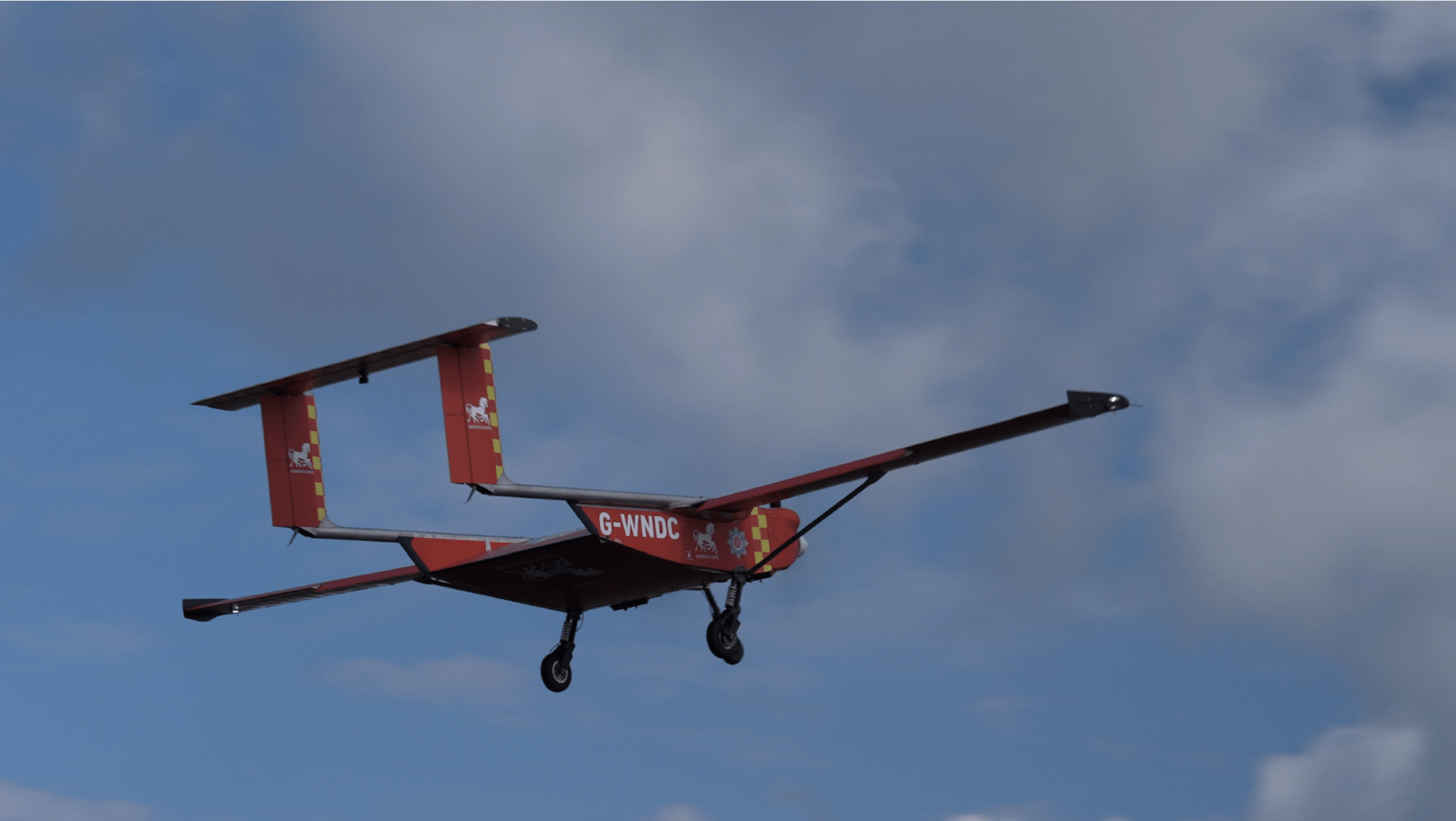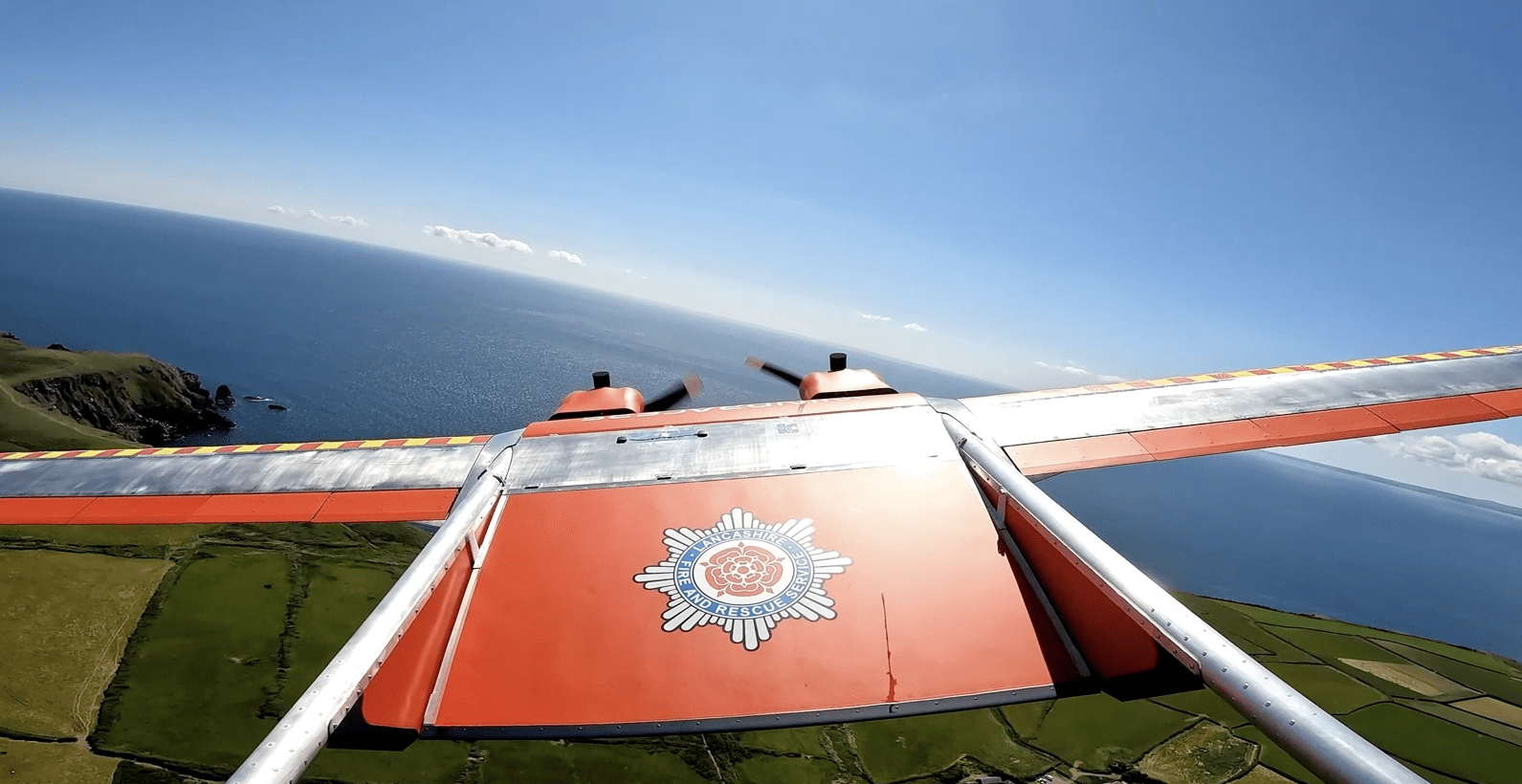Harnessing AI and Unmanned Aerial Fleets to Predict, Detect, and Combat Wildfires Across the Globe
by DRONELIFE Features Editor Jim Magil
As large, destructive wildfires proliferate across the planet, firefighting agencies are increasingly turning to artificial intelligence and drone technology to help in battling the blazes.


One day in the not-too-distant future a fleet of some 20 autonomously operated UAVs, taking off from two or three different bases, could operate in concert with one another to cover a large area, predicting where new fires are likely to start, pinpointing the location of blazes that are already under way and distributing fire-retardant material onto an inferno before it gets too badly out of control.
“The challenge from an environmental protection point of view, is how do you stop wildfires from developing into the uncontrollable phenomena that are very difficult to put out,” said Nickolay Jelev of Windracers, a UK-based developer of self-flying cargo aircraft.
With the onset of global warming, nations across the world are experiencing a dramatic increase in the development of large, destructive fires. In the U.S. alone, as of September 23, there were 42 large active wildfires being managed with full suppression strategies, according to a report by the National Interagency Fire Center.
“Current wildfires have burned 1,656,005 acres. Almost 15,056 wildland firefighters and support personnel are assigned to incidents, including 15 complex and two type 1 incident-management teams, 323 crews, 605 engines and 99 helicopters,” the report states.
To demonstrate how drones can become part of the firefighting arsenal, Windracers recently completed a series of wildfire-mitigation tests with the Lancashire Fire and Rescue Service, said Jelev, Windracers’ R&D programs manager. The tests were part of a larger project to demonstrate the effectiveness of drones equipped with AI technology developed by the University of Sheffield.
The drones have been taught to engage in “swarm” behavior, using technology developed by the University of Bristol. The swarm system allows the unmanned aircraft to communicate and interact with one another, in the same way that a school of fish or a swarm of bees can move together as one unit to avoid predators or to achieve a goal.


For the Lancashire testing program Windracers employed its Ultra drone, a large fixed-wing propeller-driven unmanned aircraft, with a maximum takeoff weight of 450 kilograms (992 pounds). The Ultra has a significant range: it’s configured to fly 1,000 kilometers (about 620 miles), and has a six- to eight-hour flight endurance.
“Our simulations have shown that 20 to 30 of those aircraft can cover a sizeable area, something the size of California,” Jelev said. Windracers envisions that ultimately the aircraft will be able to be programmed to fly autonomously, without direct human intervention.
“Right now, we are at a phase where they fly pre-programmed routes that are monitored by an operator. The operator doesn’t touch the controls during the flight but he or she monitors the progress of the aircraft while it’s flying a pre-programmed route,” he said.
To date, the bulk of Windracers’ research has been concentrated in the UK, although it has incorporated other fire-fighting agencies from foreign countries, such as the Hellenic Fire Service of Greece, into its research programs.
Earlier this month Windracers announced that Team Windracers Environmental was one of 29 international teams selected to compete in the XPRIZE Wildfire Track B competition. The next round of the competition will allow Windracers to demonstrate its firefighting capability in the U.S. in 2025 and 2026, Jelev said.
Although the specific strategies for containing wildfires vary widely from country to country and even between different jurisdictions within the same country, certain basic concepts for managing wildfires in their initial stages remain constant: predicting when and where a fire is likely to breakout, pinpointing the exact location of a fire at its beginning, and rapidly delivering fire-fighting material to extinguish the blaze before it grows to unmanageable proportions.


Using AI technology combined with drone-captured thermal and optical imaging, Windracers is able to accurately predict where a wildfire is likely to ignite.
“When you have a set number of days where the temperature and humidity levels are at a certain point, you know that the likelihood of a fire is much higher than when it’s below those thresholds,” Jelev said. So, on days where there is a high likelihood of a wildfire occurring, the fire-fighting team would deploy a large number of aircraft, a swarm, above an area seen as high-risk to monitor and look for small fire outbreaks.
If a fire is detected within the large search area, the next piece of the puzzle is about pinpointing the locating of the fire. The third component of drone-based firefighting is using swarm technology to put out the fire.
Because the Ultra drones require runway of 300 meters (984 feet), Jelev said Windracers envisions locating the aircraft at two or three different airfields from which they could be launched in order to cover a wide area.
“Once you have 15 or 20 of those aircraft airborne monitoring an area, you can then pull those aircraft together. You can concentrate on that fire effectively and acting as a swarm put it out or bring it under control,” he said.
Jelev said that too often when a headline mentions drones, it is in regard to their use in warfare, or in some other negative connotation. That why he thinks developing a drone-based firefighting system is such an exciting project.
“Its focus has really been around the drones for good, what the drones can do to help humans and enable a better outcome for society,” he said. “It’s something that we’re truly proud of as a company, that we’re working in this space.”
Read more:

 Jim Magill is a Houston-based writer with almost a quarter-century of experience covering technical and economic developments in the oil and gas industry. After retiring in December 2019 as a senior editor with S&P Global Platts, Jim began writing about emerging technologies, such as artificial intelligence, robots and drones, and the ways in which they’re contributing to our society. In addition to DroneLife, Jim is a contributor to Forbes.com and his work has appeared in the Houston Chronicle, U.S. News & World Report, and Unmanned Systems, a publication of the Association for Unmanned Vehicle Systems International.
Jim Magill is a Houston-based writer with almost a quarter-century of experience covering technical and economic developments in the oil and gas industry. After retiring in December 2019 as a senior editor with S&P Global Platts, Jim began writing about emerging technologies, such as artificial intelligence, robots and drones, and the ways in which they’re contributing to our society. In addition to DroneLife, Jim is a contributor to Forbes.com and his work has appeared in the Houston Chronicle, U.S. News & World Report, and Unmanned Systems, a publication of the Association for Unmanned Vehicle Systems International.
Miriam McNabb is the Editor-in-Chief of DRONELIFE and CEO of JobForDrones, a professional drone services marketplace, and a fascinated observer of the emerging drone industry and the regulatory environment for drones. Miriam has penned over 3,000 articles focused on the commercial drone space and is an international speaker and recognized figure in the industry. Miriam has a degree from the University of Chicago and over 20 years of experience in high tech sales and marketing for new technologies.
For drone industry consulting or writing, Email Miriam.
TWITTER:@spaldingbarker
Subscribe to DroneLife here.

